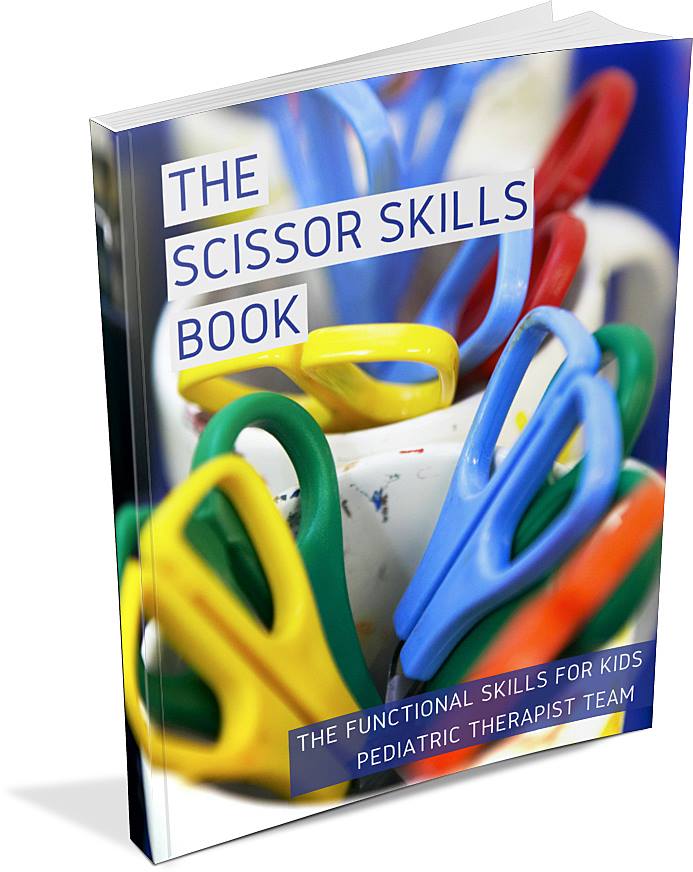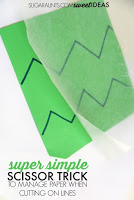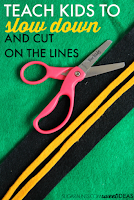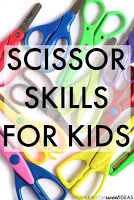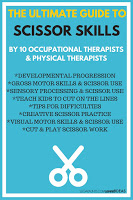Cutting with scissors is fun for many children. When a child starts to show an interest in learning to cut with scissors, it is possible that they have already started the developmental progression of skills needed for scissor use. The steps of scissor skills development typically happens through play. So how do you know how a child learns to cut with scissors? And you may be wondering just how to teach a child scissor skills. In this post, I’m sharing the progression of development that allows a child to understand what scissors are to allowing them to use scissors accurately in order to cut complicated shapes.
How do scissor skills develop
They might see older siblings or a parent using scissors on a regular basis and be familiar with how the scissors fits on their hand (although they may position them incorrectly at first). Or they might only know that that shiny tool can cut paper into two!
There are many skills needed for cutting with scissors:
Bilateral coordination
Hand strength
Separation of the two sides of the hand
Eye-hand coordination
Opening/Closing of the thumb web space
Precision of grasp and release
Because these skills develop both individually and in coordination with one another, and because the progression of scissor skill accuracy greatly depends on practice, I am not going to include typical age-ranges in this particular scissor skill post.
What you will see below is the general progression of scissor use. This development is important because we can see where accuracy and skill may breakdown with scissor use, safety, positioning, and accuracy when the underlying developmental stages are skipped or not successful.
Another huge impact relating to successful scissor use is practice time. Kids that head into kindergarten without ever having held or used a pair of scissors will struggle more greatly with the cut and paste learning activities that happen in the typical kindergarten classroom.
So, when it comes to helping kids learn to successfully use scissors, the greatest tip may be more practice!
Here is one way to practice: Use recycled paper to practice scissor skills with this scissor skills crash course.
Of course, when there are underlying areas that hinder successful scissor use such as fine motor control, visual motor integration, cognitive impairments, or other areas, then adaptations and accommodations to scissor tasks should be made.
But how can we know if kids are on the right track when cutting with scissors? The steps of development below are one way to put together the big pieces of the scissor use puzzle!
Use this scented scissor skills activity to help kids learn graded scissor use in a fun way!
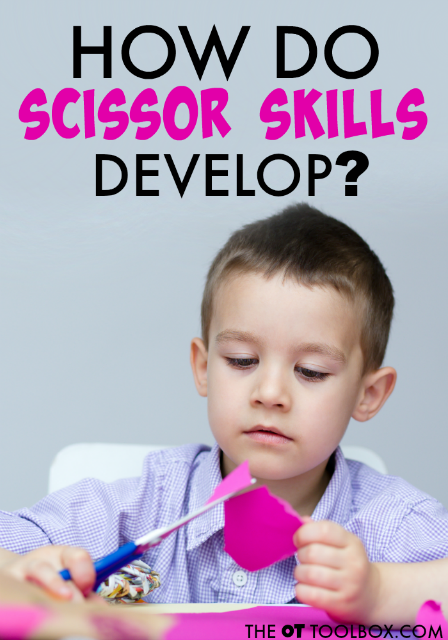
The Steps of Scissor Skills Development
Child tears paper in play
Child shows an interest in scissors
Child understands that scissors are used to cut paper
Child is able to hold scissors (incorrect hand placement)
Child is able to maintain a correct grip on scissors when positioned by an adult
Child is able to hold scissors in a correct grip without assistance
Child begins to open and close scissors
Child is able to open and close scissors using a controlled action (precision of grip begins to develop)
Child is able to hold paper and make small and random snips
Child is able to make consecutive cuts with a forward motion of the scissors, tearing the paper
Child is able to make consecutive cuts with a forward motion of the scissors, without tearing the paper
Child is able to cut straight lines forward across a page, while moving the helper hand forward (moving the paper with the scissors as in raising the shoulders/extending the elbows)
Child is able to cut straight lines forward without experiencing forward movement of the helper hand
Child is able to cut simple curves and angled lines (one direction change) without moving the assisting hand on the paper to re-position
Child is able to cut simple curves and angled lines (one direction change) while moving the assisting hand on the paper to re-position
Child is able to cut out simple lines with more than one direction change
Child is able to cut circles
Child is able to cut complicated shapes with straight and curved lines
For MORE information on scissor skills, you will want to check out The Scissor Skills Book, an e-book by myself and other pediatric Occupational Therapists and Physical Therapists. It contains everything you need to know about scissor skill development, practice, modifications, underlying challenge areas, and more! Check out The Scissor Skills Book.
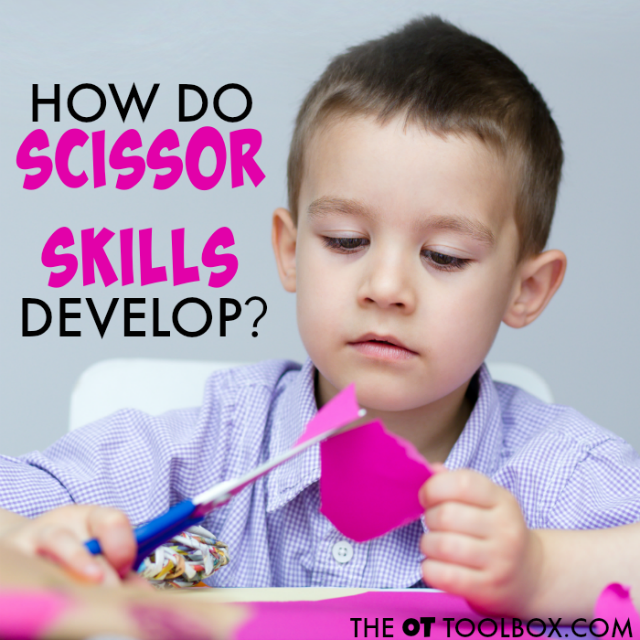
The Scissor Skills Book
Affiliate links are included in this post.
Ten Occupational Therapists and Physical Therapists have gotten together to write The Scissor Skills Book. It’s a book with resources for every underlying area needed for scissor use. It’s got tons of motor activities to address the areas needed for scissor skills. There are pages and pages of accommodations and creative ways to work on scissor use. This e-book is a giant resource for anyone who works with kids on cutting with scissors!
Chapter 2: Teaching Your Child to Use Scissors
Chapter 3: Gross Motor and Scissor Skills
Chapter 4: Fine Motor and Scissor Skills
Chapter 5: Visual Perceptual and Scissor Skills
Chapter 6: Sensory Processing and Scissor Skills
Chapter 7: Attention Challenges and Scissor Skills
Chapter 8: Helping Kids who Struggle with Scissor Skills
Chapter 9: Creative Ways to Practice Scissor Skills with Kids
Resources for Typical and Adaptive Scissors, Cutting Materials, and Further Information
References
More scissor skills development activities for kids:
Teach kids to slow down and cut on the lines
The Ultimate Guide to Scissor Skills


